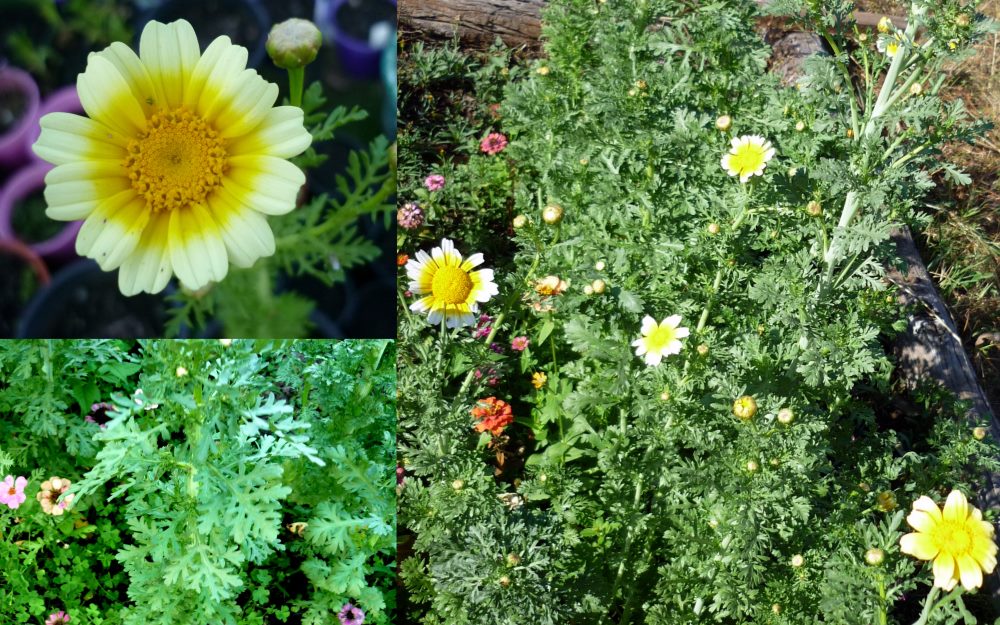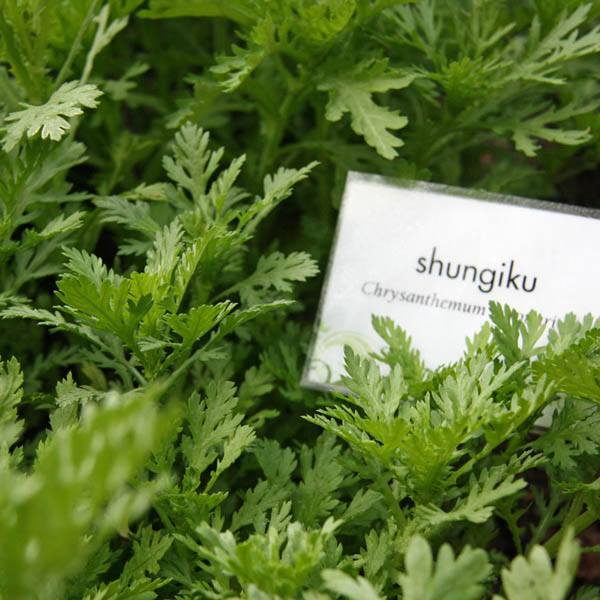Recipes for Tom Shungiku garland chrysanthemum

How to grow... shungiku Stuff.co.nz
Discover Shungiku, the edible chrysanthemum, with our guide covering taste, cooking methods, and tempting recipes like Shungiku and Shiitake Mushroom Stir-fry or Shungiku Miso Soup. Explore its nutritional benefits, seasonal significance, and culinary versatility. Get answers to FAQs, tips on purchasing, and storing Shungiku for a flavorful culinary experience.
Seminte si plante de gradina hobby Crizantema comestibilaShungiku
5. To temper fish recipes: Korean cooks may add shungiku leaves to strongly flavored fish recipes to balance the fishy flavor with bitterness. 6. In salads: Several cuisines incorporate raw shungiku leaves as a salad ingredient. The seeds are also edible, and you can sprout them for use in salads and sandwiches.

Meat Sauce Shirataki Pasta Recipe (LowCarb Miracle Noodles with Tomato
Goma-ae. Using a mortar and pestle, grate sesame seeds until most of the seeds are grated (note 2). Add the remaining Goma-ae Dressing ingredients to the mortar. Mix well. Add the goma-ae dressing to the bowl and mix well ensuring that the chrysanthemum leaves are thoroughly coated with the dressing.

Shungiku Tangho Chrysanthemum Coronarium Seeds Fair Dinkum Seeds
Group each ingredient together on a large plate. Place each egg in a small bowl in which the individual can beat the egg and dip sukiyaki. Heat a large fry pan with heavy base or shallow cast iron pot/casserole over high heat and add oil. Sauté beef slices to lightly brown on each side, about 30 seconds.
Provenance Growers Shungiku
Rinse the chrysanthemum greens under cold water. Cut the greens into 2-inch (5 cm) wide pieces. Blanch the greens in boiling water and drain. Squeeze water out. Combine the sauce ingredients in a large bowl. Add the greens and toss to combine with the sesame dressing.

Recipes for Tom Shungiku to shimeji no ohitashi / garland
Add the tofu to the sesame seeds in the mortar. Using the pestle, mash and grind the tofu until smooth. Add 2 tsp miso, 1 Tbsp sugar, 1 tsp mirin, and 1 tsp soy sauce. Mix it all together until incorporated into the tofu. Taste the tofu mixture now and add ⅛-¼ tsp Diamond Crystal kosher salt.

Pin on 음식
Prepare ice bath (a bowl of cold water + a bowl of ice) to put the blanched ssukat in to stop it from cooking further. Once the water starts boiling in the pot, 1) add just the stem parts first into pot and cook for 1 min or so. 2) Then add the top leaves and cook for another 1-2 min until the thick stems are cooked.
Raw Edible Plants Edible chrysanthemum (Chrysanthemum coronarium)
Ingredients; 1 tablespoon vegetable oil; 1 pack of Maitake (Hen of the Woods) mushrooms; 1 bunch shungiku, roughly chopped (spinach will also work) 1 small pack of katsuobushi (about 1/4 cup)

Growing shungiku, edible chrysanthemum SpadeRunner
A grassy and mildly bitter green vegetable, shungiku, or chrysanthemum greens are eaten raw or cooked in salads, soups, stews, and hot pot dishes. It has a distinctive aroma with high nutritional content. Eaten across East Asia, Shungiku (春菊, "spring chrysanthemum") are aromatic bitter greens. The green leaves can be broad-leaf or narrow-leaf with serrated.
One Blog West Alien Ingredient 19 Shungiku/Tung Ho
Dip in cold water to stop cooking further, drain well and squeeze to remove excess water. *Note: Thick stems need to be cooked longer. Leaves can be easily over cooked. Place the dressing ingredients in a bowl and mix to combine. Cut Shungiku (Edible Chrysanthemum) into 5cm length and mix with the dressing. Sprinkle with some Toasted Sesame Seeds.

SHUNGIKU Edible Chrysanthemum View All Australian Seed
In my previous post entitled Know Your Asian Greens I mentioned chrysanthemum greens that are eaten as a leaf vegetable in Asian cuisines. The Japanese call these shungiku and they are an essential ingredient in winter hot pot dishes such as nabemono and sukiyaki. Fresh and with an astringent taste, I can't imagine a big bowl of nabe without them. They should be very lightly cooked so that.

RARE New! Heirloom Small Leaf TONG HO/ Shungiku/ Edible Chrysanthem 30
Mature garland chrysanthemum greens ( Chrysanthemum coronarium) are often found in the cuisines of Japan ( shungiku ), China ( tangho ), and Korea ( sukgat ), where they lend a grassy, pungent flavor to hot pots and other dishes. The mature greens taste better cooked, but the microgreens are wonderful fresh. These young seedlings are crisp and.

Echigo Farm 春菊 Shungiku (edible chrysanthemum greens)
The green leaves can be broad-leaf or narrow-leaf with serrated edges with a fibrous stem. It has a grassy and mildly sweet flavor. They are an excellent source of potassium, fiber, vitamins A and C, calcium, and flavonoids. Eat shungiku raw or blanched in salads, or add to stir-fries and soups. It's a must-have in hot pot and sukiyaki.

Ishikari Nabe Recipe (Salmon and Miso Hot Pot in Hokkaido) Cooking
Tong Ho is a versatile ingredient that can be used in various dishes. It is often used fresh, although it can also be dried and used in teas or infusions. When using the new Tong Ho, washing it thoroughly and removing tough stems or leaves is essential. Tong Ho can be used in various dishes, from soups and stews to salads and stir-fries.

The Constant Gardener Adding a little spice to life
When you see 4 or 5 leaves growing, make a 2-2.4 inches space between the leaves; Harvest when there are 7 to 8 leaves on each shungiku; If you're going to leave 3 to 4 leaves, give some space of about 6-7.9 inches away; Shungiku is an easier and more convenient plant to grow.

Shungiku and Maitake StirFry Recipe Fresh Tastes Blog PBS Food
Add the sugar, soy sauce and sesame seed oil. Combine them well together and set aside. Wash the Shungiku. If the stem is too thick and dry, trim off the leaves and cut the stem into 2 inch pieces (5 cm). Blanch the Shungiku in boiling water in a pot for 30 seconds for leaves and 1 min for stem.